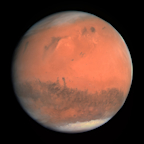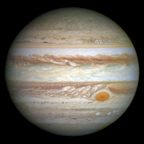Search results
Uranus is the seventh planet from the Sun.It is a gaseous cyan-coloured ice giant.Most of the planet is made of water, ammonia, and methane in a supercritical phase of matter, which astronomy calls "ice" or volatiles. The planet's atmosphere has a complex layered cloud structure and has the lowest minimum temperature (49 K (−224 °C; −371 °F)) of all the Solar System's planets.
Jul 5, 2024 · Uranus, seventh planet in distance from the Sun and the least massive of the solar system’s four giant, or Jovian, planets. Uranus has more than two dozen moons, five of which (Umbriel, Miranda, Ariel, Titania, and Oberon) are relatively large, and a system of narrow rings.
Uranus is the seventh planet from the Sun, and the third largest planet in our solar system. It appears to spin sideways.
Facts about Uranus. Uranus was officially discovered by Sir William Herschel in 1781. It is too dim to have been seen by the ancients. At first Herschel thought it was a comet, but several years later it was confirmed as a planet.
Introduction Uranus is a very cold and windy world. The ice giant is surrounded by 13 faint rings and 28 small moons. Uranus rotates at a nearly 90-degree angle from the plane of its orbit. This unique tilt makes Uranus appear to spin sideways, orbiting the Sun like a rolling ball. Uranus was the first […]
Jan 17, 2017 · Uranus, the seventh planet from the sun, may initially look like a bland, blue-green ball. But there's a lot to love about the icy giant, from its 13 rings to its 27 known moons to the fact that ...
Jul 9, 2024 · Uranus also has faint rings. The inner rings are narrow and dark. The outer rings are brightly colored and easier to see. Like Venus, Uranus rotates in the opposite direction as most other planets.
Introduction. The seventh planet from the Sun with the third largest diameter in our solar system, Uranus is very cold and windy. The ice giant is surrounded by 13 faint rings and 27 small moons as it rotates at a nearly 90-degree angle from the plane of its orbit.
Sep 26, 2019 · Uranus is the seventh planet discovered in the Solar System that also led to the discovery of the last planet, Neptune they are both referred to as ice giants. Officially recognized in 1781 after many observations in the past, it is the third-largest planet of the Solar System.
Apr 6, 2023 · Following in the footsteps of the Neptune image released in 2022, NASA’s James Webb Space Telescope has taken a stunning image of the solar system’s other ice giant, the planet Uranus. The new image features dramatic rings as well as bright features in the planet’s atmosphere. The Webb data demonstrates the observatory’s unprecedented sensitivity for the faintest dusty rings, which ...



















